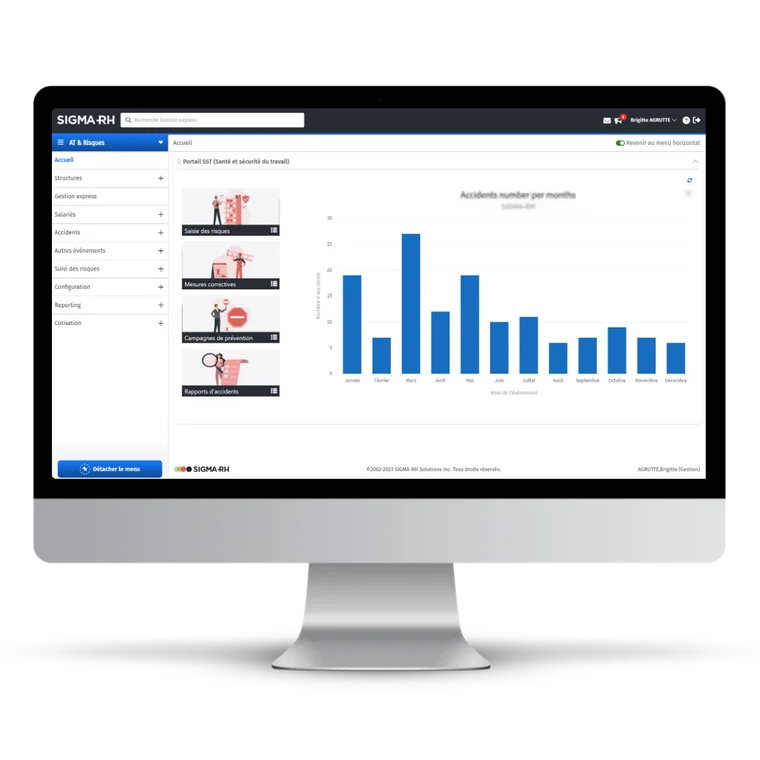Workplace Accidents and Occupational Diseases Module
- Ensure effective monitoring of workplace accidents
- Quickly report your workplace accidents online
As an expert in occupational accident management and risk prevention for over 30 years, SIGMA-HR offers a comprehensive suite consisting of 5 specialized modules to cover all your health and safety processes, boosted with its own integrated generative AI.


Create a safer and healthier work environment for your employees by actively preventing accidents, and improve your company's image.
Save time by automating your OHS processes (alerts and workflow follow-ups, prevention measures, medical visits, etc.), and facilitate exchanges between stakeholders.
Ensure compliance with the deadlines for reporting and disputing accidents, as well as the traceability of information on occupational accidents and risk exposure
Control your social contributions, reduce the cost of occupational accidents, decrease overall absenteeism and avoid fines and sanctions related to non-compliance.

HR Managers and Executives
Ensure your employees are protected against various risks, improve their working conditions, and project a positive image of your company. Access strategic dashboards, analyze trends in health and safety, and make informed decisions.
Occupational Health and Safety (OHS) Manager
Ensure that all health and safety regulations are complied with in the event of an incident or occupational illness. Identify risks, implement corrective measures, and help reduce the number of accidents. Generate meaningful reports for the company.
HR Manager, Staff Management
Efficiently manage the administrative aspects of OHS, such as monitoring medical visits and vaccinations, managing sick leaves and workplace accidents.
Field Employee
Report incidents, access safety data sheets, and consult safety instructions to ensure your own safety.





“With SIGMA-HR, we have better control over our employees’ exposure to occupational hazards. We also save a lot of time in the administrative management of workplace accident files.”
HR Development Manager Céline R.
The OHS Manager is responsible for preventing risks and accidents that could compromise the safety of employees and subcontractors. They advise and assist the company’s management while implementing an OHS culture that takes into account the improvement of quality of life at work.
Our OHS Suite supports them in this approach by ensuring compliance with regulatory obligations, equipping them to effectively monitor workplace accidents and occupational diseases, and reducing contributions to the Workers Compensation Board. SIGMA-HR facilitates access to and exploitation of data, optimizing high-level analyses and facilitating decision-making. Finally, by enabling the creation of statistics and reports related to the company’s objectives, it contributes to positioning the OHS Manager as a strategic player in the organization.
What is the Purpose of Occupational Health and Safety (OHS)?
The goal of Occupational Health and Safety (OHS) is to ensure a safe and healthy work environment for employees. It aims to prevent workplace accidents and occupational illnesses by identifying, assessing, and controlling work-related risks. OHS includes policies and procedures to minimize risks, training to educate employees on safe practices, and regular monitoring to ensure compliance with safety standards. By promoting employees' physical and mental health, OHS contributes to productivity and job satisfaction, while reducing costs related to accidents and sick leaves.
How to Implement an OHS Program?
To implement an Occupational Health and Safety (OHS) program, start by assessing the risks in your work environment. Identify potential hazards and evaluate their severity. Then, develop and implement policies and procedures to control these risks. Train your employees on safety practices and ensure they understand the importance of OHS. Set up a reporting system for incidents and accidents, and regularly review procedures for improvement. Finally, commit to continuous improvement to maintain a safe and healthy work environment.
Who is Responsible for OHS in a Company?
The responsibility for Occupational Health and Safety (OHS) is shared: the employer ensures a safe environment and complies with regulations. OHS managers, often from the HR or the Environment Health and Safety department, develop and implement safety policies, coordinate prevention, and monitor compliance. Employees must follow safety rules, use protective equipment, and report hazards. Personnel representatives, offering a consultative and control perspective, ensure the respect and adequacy of safety measures
We noticed that you're browsing from United States. Would you like to switch to Canada - EN?